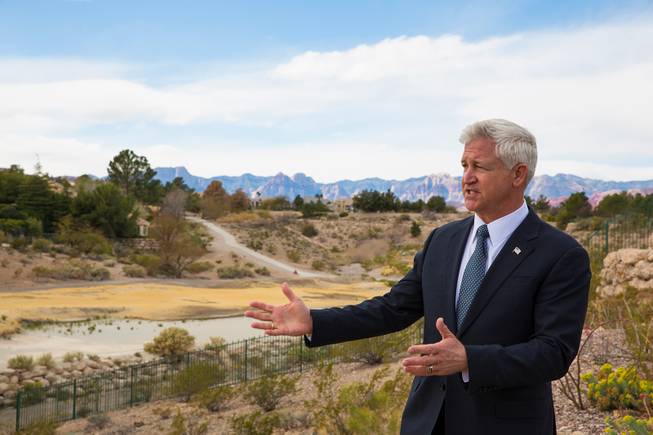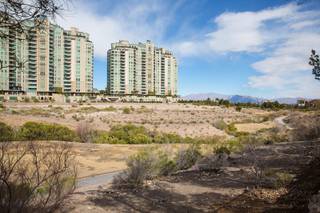
Councilman Steve Seroka is shown at the site of the defunct Badlands Golf Course, surrounded by the Queensridge community, Monday, Feb. 19, 2018.
Tuesday, Feb. 20, 2018 | 2 a.m.
Related news
Residents are fighting the latest iteration of plans to develop housing on the site of the former Badlands Golf Club after a recent court ruling against the new owner of the land.
A judge said in January the Las Vegas City Council abused its discretion and violated the law by allowing development plans to move forward. The lawsuit filed by residents against the city and developer Yohan Lowie was the result of a battle that has cost residents millions in estimated legal fees and lost home values.
New but similar plans are set to come before the council Wednesday. The new maps only seek single-family residential housing and leave out the multifamily units included in the previous set of plans. City policy says plans that are denied cannot come back before the council until at least a year later, although in this case the court ruled against the council’s decision to approve.
Councilman Steve Seroka was elected on an anti-Badlands platform against former councilman Bob Beers, who’d voted in support of the project. Seroka said the Badlands situation is new to Las Vegas, where a golf course owner sold land that is completely surrounded by a master-planned community. He’s proposing that the city adopt a set of guidelines based on best practices from states including Florida and Arizona, where golf course communities have dealt with similar issues.
“The city and the developer lost the court case, and it says the city exceeded its authority and violated the law,” Seroka said. “My concern about Wednesday’s events are that I would hope the city or the developer pulls their request because these three parcels appear to be of the same background that the judge just ruled against the city. So I’m concerned about us operating outside the law.”
The owner contends that the land can be developed based on an old zoning rule, while opponents of the plan say master plans for the area rule out putting homes there, as does a 100-year floodplain under the Federal Emergency Management Agency. The surrounding homes use the former golf course land as drainage, and building homes and roads there could cost millions to build the infrastructure to divert water from the community.
A call to Lowie was not returned Monday.
Resident Frank Schreck, a longtime Nevada gaming lawyer, said the time he’s volunteered on the legal fight against the project is equal to as much as $1.3 million in billable hours. Some of the other residents have pooled their resources to spend about $2 million on the fight so far.
Schreck said the Peccole family, longtime valley developers, sold the 250 acres of golf course property for $7.5 million, 3 percent of market value. The family sold at that price because they knew it could not be developed, he said, requiring Lowie to protect them from homeowner lawsuits and buy without a contingency on entitlements that would allow development.
Schreck said there were no entitlements to build residences on the former golf course until the council approved 435 condominiums in February, which the court threw out. The space was park and recreation open space, although an old zoning label that is no longer in use says the owner can build less than eight residences per acre.
“This judge’s decision validates everything we’ve been saying for over two years,” Schreck said.
The current maps up for consideration Wednesday call for an exception to allow septic tanks rather than connections to the sewer system. Seroka said the developer has not secured the ability to use a road from the area homeowners association to be able to connect the line. Without permission to use the road, he had to elevate the waste to push it out to the sewer, increasing costs.
Seroka said the septic tank situation is a self-imposed hardship on the part of the developer.
“The only thing that prevents him from gravity-feeding the sewer system is his inability to just talk to the existing homeowners association and residents,” he said. “If we could work through that, not only would the septic requirement go away, the contention about the whole issue would go away. So really this comes down to a dialogue between the developer and the existing residents.”
Seroka said it’s a coincidence that his policy outline and the Badlands plans are coming up on the same agenda. He said if the council eventually decides to pass his policy and make it apply to the Badlands case, which spurred Seroka to pursue the guidelines.
Residents are seeing an impact on their property values, although the council has to ignore the impact on property values when making its decision. Eva Thomas bought her corner lot in 1998 and has seen its value drop from $1.7 million in 2017 to $520,000 this year, leaving her underwater on what she owes.
Thomas’ backyard view stretches from a portion of the golf course that was proposed for condominiums to another swath slated for single-family residences. Residents say a wall would have divided the communities, blocking views of the deep dirt ditches and former golf course, which the new owner has allowed to turn from green to brown.
She said she’s hired an attorney to negotiate to get the bank to take the home back.
“There is such uncertainty of what’s going on all the way around,” Thomas said. “Nobody really wants it … I can’t give it away.”
Resident Dale Roesener and his wife, Elaine, had their home built with golf course views in front and back, and have been living there for about 14 years. Those areas would have houses on lots a fraction of the size of theirs and the other existing lots, which Roesener said is contrary to a requirement that adjacent properties be comparable in size.
Roesener said his wife spent a lot of time on their home’s unique design. The couple bought a property for the home but had to sell it when they couldn’t get certain building approvals, buying their current lot instead.
“We put a lot of effort and research into it and actually had this house approved before we closed on the lot,” Roesener said from his home in the Queens Ridge community. “We had a learning experience.”
Residents are concerned about the development’s impact on the birds of prey and other wildlife that use the space. There are no local or state protections in these situations for wildlife that isn’t endangered.
Trees have been cut down, with stumps visible in the field from Thomas’ backyard, she said, and birds and rabbits have been unable to find food and water.
Roesener said he’s also spotted what he believes was a desert tortoise in the area. Desert tortoises are considered “threatened” or “vulnerable,” both steps above the endangered designation.
“It’s much more than the view,” said resident and former wastewater engineer Gordon Culp. “It’s the traffic, the congestion, the multiple years of construction, the noise, all those things, schools, schools are overloaded.”
Culp, a board-certified environmental engineer, said the area proposed for development is the last place he’d put a septic tank, with drainage and other environmental pressures spelling failure in about 10 years. He and his wife, Anne Smith, who is also an engineer, were also among the first to buy a lot in the area in 1998.
Smith said residents have tried to negotiate with the developers to get the wall built further from their property lines.
“We said what could we live with? And we were willing to negotiate in good faith,” she said. “It was just lip service (from the developer) as far as we’re concerned.”

